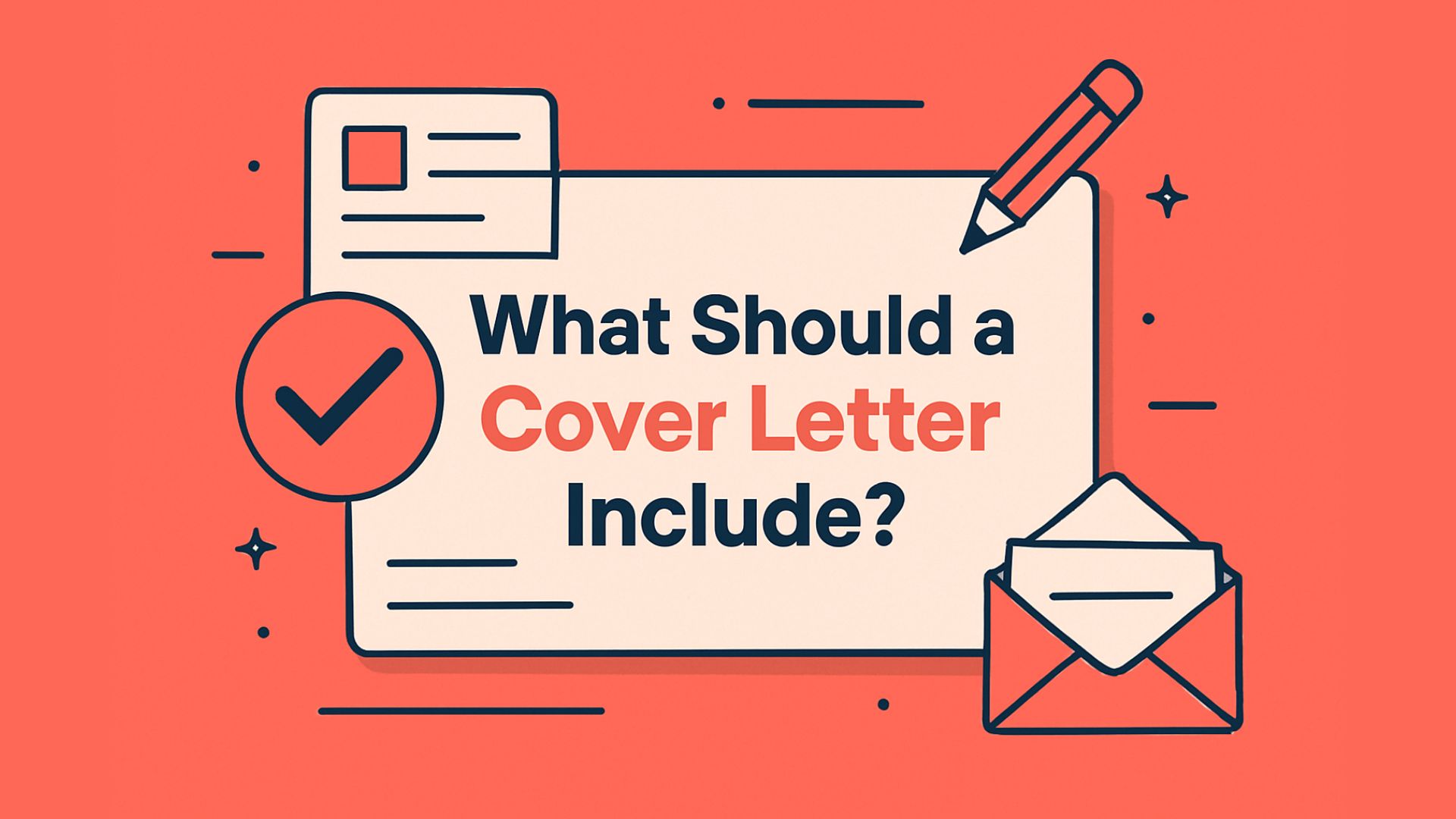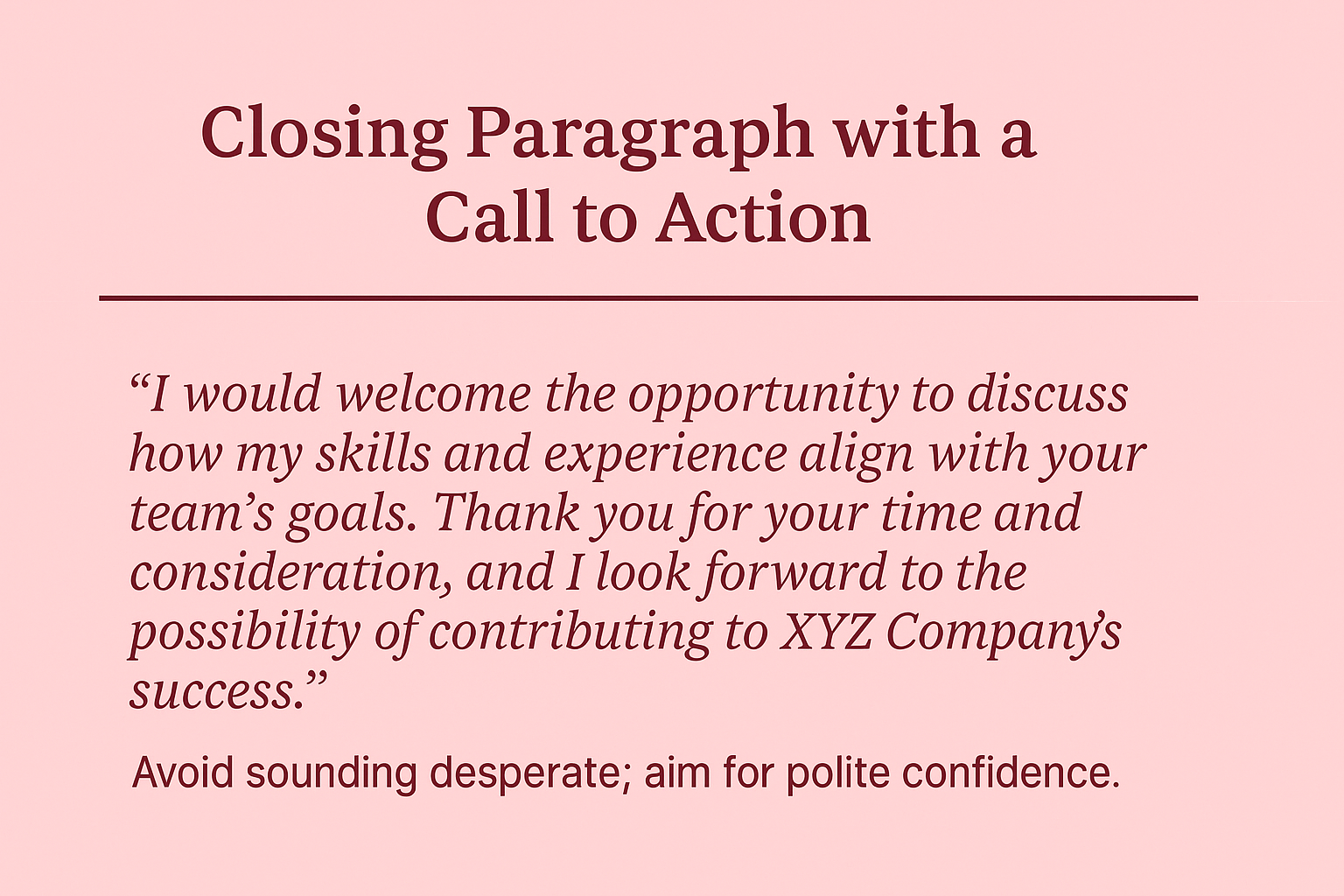What Should a Cover Letter Include?


TL;DR
A strong cover letter includes a clear header, a personalized greeting, an attention-grabbing opening, a skills-to-role alignment section, evidence of your impact, and a confident closing with a call to action. Think of it as a concise, tailored pitch that connects your experience to the employer’s needs—not a repetition of your resume.
A well-structured cover letter remains one of the most powerful tools in your job application arsenal—even in 2025. While applicant tracking systems (ATS) continue to screen for keywords and formatting, real hiring managers and increasingly, AI-powered recruitment tools, are looking for clarity, relevance, and genuine alignment. A thoughtfully crafted letter can make the difference between blending in and standing out.
Understanding what a cover letter should include is essential if you want to capture attention quickly. A strong cover letter structure showcases your professional identity, demonstrates how your skills match the role, and sets the tone for a more personal connection with the employer. It’s not just about listing achievements; it’s about telling a clear, compelling story.
In this guide, we’ll break down the key components of a cover letter, explain why each section matters, and show you how to write a cover letter in 2025 that gets noticed by both humans and algorithms.
Pull-out Tip: A cover letter isn’t about repeating your resume — it’s about connecting the dots between you and the job.
Essential Elements Every Cover Letter Must Include
1. Professional Header with Contact Info
The header sets the tone for your entire cover letter. A clean, properly formatted header makes your application look polished and ensures that both hiring managers and applicant tracking systems (ATS) can quickly identify your details.
Your header should include:
Your full name and professional title (e.g., Marketing Analyst, UX Designer)
Email address (professional, not personal)
Phone number
LinkedIn profile or portfolio link
City and state (no need to list your full home address in 2025)
Beneath your information, include:
The employer’s name
Company name
Date of submission
This traditional layout isn’t outdated—it communicates professionalism and ensures your application is easy to reference and file. Whether your cover letter is read by a recruiter or parsed by AI, a well-structured header prevents your details from getting lost.
Related: How to Start A Cover Letter
2. Personalized Greeting (Not “To Whom It May Concern”)
A personalized greeting immediately signals effort and attention to detail. Hiring managers are more likely to engage with a letter addressed directly to them, and studies show it can boost response rates significantly.
How to find the hiring manager’s name:
Check the job posting for contact information.
Search the company’s website or LinkedIn team page.
Call the company’s HR department and ask politely.
If you absolutely cannot find a name, use a role-specific greeting such as “Dear Hiring Manager,” or “Dear Finance Team Recruiter.” Avoid generic openings like “To Whom It May Concern,” which feel outdated and impersonal.
3. Compelling Opening Paragraph (Hook)
The opening of a cover letter should grab attention within the first few lines. Show genuine enthusiasm for the role and highlight one relevant skill or achievement that aligns with the job description.
Entry-level example: “I am excited to apply for the Marketing Assistant role at XYZ Company. With strong academic training in digital strategy and hands-on experience managing a student campaign that grew engagement by 40%, I am eager to contribute my skills to your team.”
Senior-level example: “With over a decade of experience leading cross-functional teams in SaaS product development, I was immediately drawn to XYZ Company’s mission to innovate customer solutions. I’m confident my track record of driving 30% annual growth can add value to your organization.”
4. Why You’re a Great Fit (Skills + Job Match)
This section should demonstrate alignment between your abilities and the employer’s needs. Mirror key phrases from the job description so your letter resonates with both recruiters and ATS software. You can also highlight familiarity with AI sales conversation tools if the role involves modern revenue technology, as these platforms improve call outcomes, objection handling, and post-call analytics.
Example bullet list:
Proven ability to manage cross-departmental projects with efficiency
Strong command of data analytics tools (Excel, SQL, Tableau)
Consistent record of surpassing sales quotas by 15–20%
Where possible, quantify impact with metrics to give your claims credibility.
5. Relevant Achievements / Evidence Section
Instead of vague statements, provide one or two specific accomplishments that prove your ability to perform. Use the STAR method (Situation, Task, Action, Result) to keep your story concise and results-oriented.
“Implemented a new onboarding workflow that reduced training time by 25% while boosting employee retention.”
This evidence-based approach reassures employers that you can deliver measurable impact.
6. Closing Paragraph with a Call to Action
End your cover letter by reinforcing your enthusiasm and suggesting the next step. Keep your language confident, forward-looking, and professional.

Example closing:
“I would welcome the opportunity to discuss how my skills and experience align with your team’s goals. Thank you for your time and consideration, and I look forward to the possibility of contributing to XYZ Company’s success.”
Avoid sounding desperate; aim for polite confidence.
7. Professional Sign-Off
The best way to sign off a cover letter is with a traditional, respectful closing. Reliable choices include “Sincerely,” “Best regards,” or simply “Best.”
Avoid casual or unprofessional sign-offs like “Cheers,” or “Thanks in advance.”
Optionally, you can add a digital signature above your typed name to give it a polished, personal touch.
Bonus Elements to Make Your Cover Letter Stand Out
Adding subtle, strategic touches to your cover letter can make it more memorable without compromising professionalism. These “bonus” elements won’t apply to every situation—but when used thoughtfully, they can help you leave a stronger impression on both recruiters and applicant tracking systems (ATS).
Add a PS Line (Optional, Strategic)
A P.S. line at the end of your cover letter is a simple but powerful way to catch the reader’s attention. Studies in marketing and communications show that readers’ eyes naturally gravitate toward postscript lines, making it a clever place to highlight something unique about yourself.
Use this space to emphasize a standout skill, achievement, or value proposition that might otherwise get buried in the letter. Keep it short—one sentence is plenty.
Example:
P.S. I recently led a cross-functional project that boosted conversion rates by 28% in just three months—I’d love to bring the same energy to your team.
This optional touch can leave a lasting impression, especially when a hiring manager is quickly scanning dozens of applications.
Hyperlink Smartly
Hyperlinks can make your cover letter more dynamic—if used correctly. Rather than pasting raw URLs, embed links in clear, descriptive anchor text. This improves both readability and SEO, and helps ATS systems properly parse your content.
When to include hyperlinks:
Link to your LinkedIn profile when it’s polished and up to date.
Add a portfolio link if you’re in a creative or technical field (designers, developers, writers, marketers, etc.).
Include specific work samples to support achievements mentioned in your letter.
Anchor text best practices:
✅ Use descriptive language: “View my portfolio” instead of “Click here.”
✅ Keep anchor text concise and relevant.
✅ Place links naturally within sentences.
This not only makes your cover letter cleaner but also increases the likelihood of hiring managers exploring your work further.
Keep Formatting Clean and ATS-Friendly
Even the most compelling cover letter can fail if the formatting isn’t compatible with ATS software. Clean, consistent formatting ensures your document is easy to read, scan, and parse by both humans and machines.
Formatting best practices:
Font: Use standard, professional fonts like Arial, Calibri, Times New Roman, or Helvetica. Stick to 10–12 pt size.
Related: Cover Letter Font Size
Spacing: Use single spacing within paragraphs and one blank line between sections.
File Type: Save and submit as a PDF to preserve formatting—unless the job posting explicitly asks for a DOC file.
Avoid: Headers, footers, tables, text boxes, or graphics that can confuse ATS systems.
Related: Top 10 Mistakes to Avoid in Your Job Application Letter
FAQ
What is the most important part of a cover letter?
The most important part of a cover letter is the opening paragraph. It needs to immediately show enthusiasm for the role and highlight one relevant skill or achievement that aligns with the job description. A strong hook determines whether the rest gets read.
How long should a cover letter be in 2025?
A cover letter should be 250–400 words—no more than one page. Keep it concise, structured, and tailored to the job, focusing on impact rather than repetition.
Read: How long should a cover letter be?
Should I include salary expectations in a cover letter?
Only include salary expectations if the job posting explicitly asks for them. Otherwise, it’s better to focus on your qualifications and discuss compensation later in the hiring process.
Can I use the same cover letter for multiple jobs?
No. A generic cover letter signals lack of effort and usually gets ignored. Customize each one to mirror the job description and highlight the most relevant skills for that specific role.
What if I don’t know the hiring manager’s name?
If you can’t find the name after searching the job post, company website, or LinkedIn, use a role-specific greeting like “Dear Hiring Manager” or “Dear Marketing Team Recruiter.” Avoid outdated phrases like “To Whom It May Concern.”
How should I format my cover letter for ATS?
Use a clean, simple layout with standard fonts (e.g., Arial, Calibri), no text boxes or headers, and save it as a PDF unless instructed otherwise. Avoid decorative elements to ensure ATS software can read it correctly.
Should a cover letter be attached or in the email body?
If you’re applying through a portal, attach it as a PDF. For email applications, you can either attach it or paste the content in the body with a brief note—just make sure the formatting stays clean and professional.
Is a cover letter still necessary with online applications?
Yes. Even in 2025, a well-written cover letter can set you apart, especially when AI screening tools look for tailored language. It’s your chance to personalize your application and show genuine interest.